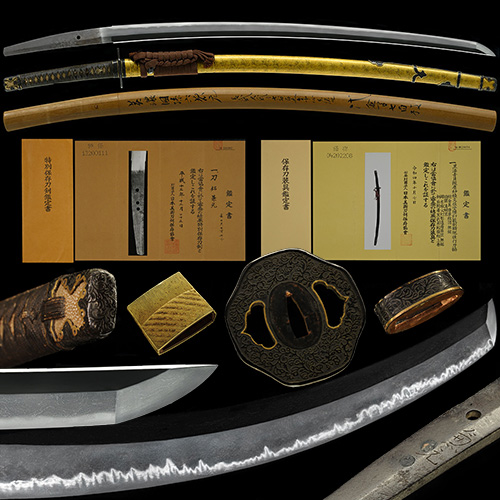
兼元 刀 Kanemoto Katana
No.257096兼元 孫六 保存刀装具 金八重牡丹塗鞘打刀拵付 複雑に華やかに乱れ刃中の働き見事で地刃冴える傑作 二尺二寸八分Kanemoto Magoroku Hozon Tousougu With Kin Yae-Botan(eight-layered peony-) Nurisaya Uchigatana Koshirae Complex and gorgeous Midare A masterpiece the works well in sword and Jiba is clear, 68.8cm
ご成約Sold
- 銘表Mei-Omote
- 兼元
- 登録証Registration
- 熊本県 Kumamoto 昭和44年8月18日 8/18/44(Showa)
- 時代Period
- 室町後期大永頃Late Muromachi period, around Taiei era
- 法量Size
-
刃長 68.8cm (二尺二寸八分) 反り 2.0cm
元幅 3.1cm 先幅 2.1cm 元重 0.58cm 鎬厚 0.73cm 先重 0.45cm 鋒長 3.7cm 茎長 19.9cm 重量 736gHachou 68.8cm (二尺二寸八分) Sori 2.0cm
Moto-Haba 3.1cm Saki-Haba 2.1cm Moto-Kasane 0.58cm Shinogi-Thikess 0.73cm Saki-Kasane 0.45cm Kissaki-Chou 3.7cm Nakago-Chou 19.9cm Weight 736g - 国Country
- 美濃Mino
- 姿Shape
- 鎬造、庵棟、身幅広く、反り深く、中鋒やや延びる。Shinogidukuri, Iorimune, Wide Mihaba, Deep Sori, Chu-Kissaki slightly extended.
- 鍛Kitae
- 板目肌に、杢目肌・流れ肌交え、地沸微塵に厚くつき、地景入り、淡く映り立ち、鉄冴える。Itamehada, Mokumehada, Mixed Nagarehada, Jinie entered fine and thick, Chikei entered, Faintly Utsuritachi, Iron is clear.
- 刃文Hamon
- 互の目に、小互の目・尖り刃など交じり、湯走り・飛び焼き・二十刃など頻りに掛り、足・葉よく入り、沸よくつき、金筋・砂流し幾重にも頻りに掛り、匂口明るく冴える。Gunome, Small-Gunome, Mixed Togariba, Yubashiri, Tobiyaki, Nijuba shikirini-kakari, There are many Ashi and You, Nie entered frequently, Kinsuji and Sunagashi hangs frequently over and over, Nioikuchi is bright and clear.
- 帽子Boushi
- のたれ込んで先掃き掛けて返る。Notarekonde-sakihakikakete-kaeru.
- 茎Nakago
- 生ぶ、先入山形、鑢目鷹ノ羽、目釘孔三内二埋め。Ubu, Sakiiriyamagata, Yasurime-Takanoha, Mekugi are fill in two of three
- ハバキHabaki
- 金着二重。Double Kinkise(Double layered with gold.)
- 拵Sword mounitings
- 日本美術刀剣保存協会 保存刀装具
金八重牡丹塗鞘打刀拵[江戸時代]
法量
長さ104.8cm 反り3.9cm
説明
鐔 赤銅地唐草図赤銅覆輪、 総金具 赤銅地唐草図金色絵。 目貫 素銅地蛸図。 鞘は保存刀装具指定後に塗り直してあります。Nihon Bijutsu Token Hozon Kyokai(Japanese Art Sword Preservation Association) Hozon Tousougu
Kin Yae-Botan(eight-layered peony-) Nurisaya Uchigatana Koshirae(Edo period)
Length:104.8cm
Sori:3.9cm
Tsuba:Syakudouji Karakusazu Syakudou Fukurin
All Metal fittings: Syakudouji Karakusa(arabesque design) Kiniroe
Menuki: Suakaji Tako-zu(octopus design.)
The scabbard has been repainted after being specified by Hozon Tosougu. - 説明Drscription
- 兼元は、美濃三阿弥系の鍛冶で、古来名高いのは室町中期大永(1521年〜)頃の二代兼元(通称孫六)で、末古刀の最上作として二代兼定と共に末関を牽引し、また、最上大業物としても知られるように切れ味に優れ、古来より武人に愛された。二代兼元以降代々孫六を通称としているが、「関の孫六三本杉」といわれるように兼元の代表的な刃文が三本杉乱れで、これは尖りごころの互の目が連なる様が三本杉のように見えたことからついた呼び名である。
この刀は、身幅広く反り深く、中鋒延びごころの美しい姿で、地沸微塵に厚くつき淡く映り立つ冴えた地鉄に、互の目に、小互の目・尖刃など交え、湯走り・飛び焼き・二十刃など頻りに掛り、複雑に華やかに乱れ、沸が明るく輝き、金筋・稲妻・砂流し頻りに掛るなど刃中の働き見事で、匂口明るく冴える傑作である。Kanemoto is a blacksmith of the Mino SanMiami lineage, and the one who has been famous since ancient times is the second Kanemoto (commonly known as Magoroku), who lived in the middle of the Muromachi period and was known as Magoroku. , Also known as the best Ohwazamono, it has excellent sharpness and has been loved by warriors since ancient times.
Since Kanemoto II, he has been known by the common name Magoroku for generations, but Kanemoto's representative Hamon is Sanbonsugi(Three Cedars)-Midare, as it is said to be ``Seki no Magoroku Sanbonsugi(Three Cedars)'', which looks like a pair of eyes with a pointed heart. It is the name given because it looked like Sanbonsugi(Three Cedars).
This sword has wide Mihaba and Deep Sori, has a beautiful shape with Chu-Kissaki Nobigokoro. Jigane is bright and faintly Utsuritachi with a thick and finely Jinie. Gunome, Small-Gunome, Mixed Togariba, Yubashiri, Tobiyaki, Nijuba-shikirinikakari, The Midare is complex and gorgeous. Nie shines brightly, Kinsuji and Inaduma, Sunagashi-shikirinikakaru, It works well in sword, Nioikuchi is bright and clear.



